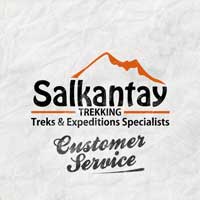If you’re considering an off-the-beaten-path trek that takes you to some of the most beautiful places on Earth and to rural communities, the Ausangate Trek is a fantastic option. Whether you’ve already decided on this route or are still deciding, we’ve put together the most frequently asked questions about the Ausangate Trek to help you make up your mind.
Before reaching out with a general inquiry, we recommend you read through this page to see if you can find the answer you’re looking for, along with our Salkantay trekking information and Peru travel information pages.
If you’re considering an off-the-beaten-path trek that takes you to some of the most beautiful places on Earth and to rural communities, the Ausangate Trek is a fantastic option. Whether you’ve already decided on this route or are still deciding, we’ve put together the most frequently asked questions about the Ausangate Trek to help you make up your mind.
Before reaching out with a general inquiry, we recommend you read through this page to see if you can find the answer you’re looking for, along with our Salkantay trekking information and Peru travel information pages.
Frequent Questions
Here is a list of the frequently asked questions of our passengers
-
Is the Ausangate Trek Worth It?
Yes. Most definitely! The Ausangate Trek is one of the best alternative routes in the Cusco region. This trek is especially suited to those who like to get off-the-beaten-path and escape the large crowds on some of the more popular trails.
You’ll be rewarded with some of the most incredible scenery imaginable after relatively difficult days of trekking. Expect to see snowy mountain peaks, crystalline lagoons, and plenty of local flora and fauna.
-
Is the Ausangate Trek Difficult?
We rate the Ausangate Trek as moderately challenging, with some days more difficult than others. The main reason for the difficulty is the high altitude that can really make short distances seem a lot longer. You’ll also be doing some uphill hiking, which can seem extremely tough this high up.
On the classic 5 day Ausangate Trek, the second and third days are the toughest. This is because you’ll be trekking up to passes at very high altitudes.
-
How Far Do We Walk Every Day?
Every day, you’ll walk around 6–7 hours on average. You’ll walk the furthest on day 4, but because it’s not as much uphill, it isn’t as difficult as days 2 and 3. Below is a breakdown of the distance you’ll cover on each day of the Classic Ausangate 5 Days Trek:
- DAY 1: 10 km / 6.21 miles
- DAY 2: 12.1 km / 7.5 miles
- DAY 3: 13 km / 8.1 miles
- DAY 4: 15 km / 9.3 miles
- DAY 5: 7.1 km / 4.4 miles
-
How Much Does the Ausangate Trek Cost?
The price of the Ausangate Trek will differ depending on the company you travel with and the number of days you opt for. This is a summary of the costs when you decide to travel in a group tour with Salkantay Trekking. Prices are per person.
- AUSANGATE & RAINBOW MOUNTAIN TREK 4 DAYS — $500 USD
- AUSANGATE TREK 5 DAYS — $550 USD
-
Can I Rent Equipment for the Ausangate Trek?
Yes. On every one of our treks, we’ll include the accommodation and a sleeping mat, so you don’t need to worry about those. There is the option to hire extra equipment if needed, though.
All the items we rent are top-of-the-range and can be reserved in advance or at the briefing the night before the trek. Items available to rent are:
- A sleeping bag for -15°C and a sleeping bag liner.
- Thermarest luxury air mattress.
- Adjustable walking sticks.
If you already have these items, don’t hesitate to pack them. Just keep in mind that there are weight restrictions per person.
-
How Can I Prepare Physically for the Trek?
The Ausangate Trek is at high altitude and can be challenging to many who take it on, especially if you’re coming from sea level. You’ll be heading up to pretty high altitudes and hiking for a large part of the day.
This is why we suggest you prepare yourself before you travel to Cusco and in the few days leading up to the hike. If you do, you’ll enjoy the trip much more and won’t find it as tough. Here are a few tips to keep in mind to prepare yourself:
- At home, before you leave for your trip, you’ll need to do regular exercise. This should include cardiovascular activities like regular hikes. Ensure you travel over varied terrain and over a few days.
- A healthy, well-balanced diet is a must to keep your body in optimal shape. While you’re on the trek, we’ll provide you with meals full of nutrition in a wide variety of dishes.
- Before you leave for the trek, you’ll have to spend 2–3 days in Cusco or the surrounding region to acclimate. When you don’t do this, your risk of succumbing to altitude sickness is much higher.
- Don’t forget to bring well worn-in hiking boots. New shoes can cause a lot of pain over a longer period and you’ll be suffering when you should be enjoying yourself.
-
Is Water Included on the Trip?
Yes. You’ll need to make sure you take enough water for the first morning of your trek, but after this, we’ll provide you with boiled water to fill your bottle or pouch with at every meal and campsite. The water is clean and perfectly safe for you to drink, so you don’t need to worry in that respect.
Make sure you take a reusable bottle or Camelbak to use the entire trek. We prefer not to use plastic bottles to help protect the environment and the routes.
If you do need any extra water at some point, you’ll find the occasional kiosk selling it and snacks along the way.
-
What Is the Food Like on the Trek?
One of the aspects you’re likely to be most amazed by is the food on the trek. Most guests mention how much they enjoyed the array of dishes prepared by our professional chefs on the route. You’ll be blown away by the food you eat in the middle of the mountains.
We know that nutrition on the routes is essential, as you need plenty of energy to get you through each day. For this reason, we worked long and hard, together with our chefs and top nutritionists to put together the most well-rounded menu possible for the Ausangate Trek.
Every time you sit down for a meal, you’ll be greeted with an array of options for you to choose what you like from and that include all the essential food groups for a well-balanced meal every time.
If you have an allergy or prefer not to eat certain foods, you don’t need to worry. All you need to do is let us know before the trek and we’ll ensure you eat as well as everyone else in your group and enjoy all the fresh and local ingredients possible.
It gets even better—we¿ll also give you a cloth bag that we provide snacks for every morning to keep you going. We also prepare a special “tea time” at every camp with tasty light bites and hot drinks to tide you over until dinner.
You can see that you certainly won’t go hungry on the Ausangate Trek and will get to try many of our traditional Peruvian dishes.
-
Do I Need to Bring Extra Money for the Trek?
Although everything is paid for in advance and included in the package, you definitely need to take some extra cash with you for the trek. Around 300 Peruvian soles are enough. Don’t take dollars, as these aren’t liable tender in rural parts of the country.
You might not need to use any at all, but it’s always a good idea in case of emergencies or if you need to buy anything along the way. You might also find that you feel tired on a part of the route and would like to hire a horse for a small section.
-
Do I Need a Permit for the Ausangate Route?
The Ausangate Trek does not require you to buy a permit in advance.
-
Can I Do the Trek With Kids?
Due to the trek being a little challenging and the climate conditions, we don’t recommend you travel with small children. It’s likely you’d need to carry them a lot of the way—making it even harder for you.
We recommend that the youngest age that children should join this hike is 12 years old. As long as your child is active and you do lots of walking back home, you should be fine.
-
Will I Have Wifi During the Trek?
If you’re hoping to check in on your emails or see how friends and family are doing while on the route, you won’t be able to on the Ausangate Trek. You’ll be in a very rural part of the country where they don’t have access yet.
-
Will I Be Able to Charge My Devices During the Trek?
No. On the Ausangate Trek, there’s nowhere to charge your electronic devices. We recommend you take a portable power pack if you have cameras or phones you want to keep charged.
-
Will I Have Access to Bathrooms Along the Trek?
Yes. There are bathrooms along the way. Salkantay Trekking also takes chemical bathrooms for you to use along the way if needed.
-
Will I Be Able to Have a Shower During the Trek?
No. On the Ausangate route, there are no showers. However, you’d probably find it too cold to get into the shower anyway, so you likely won’t need one.
-
Can I Rent an Extra Horse on the Trek?
Yes, you are able to rent a horse. However, you’ll need to do it through an agency and let us know beforehand.
-
What’s the Difference Between the Different Ausangate Treks?
At Salkantay Trekking, we offer two variations of the Ausangate Trek, over four or five days.
The main difference is that on the 4-day trek, you’ll visit Rainbow Mountain, aka Vinicunca, which is a highly sought-after tourist destination. Do keep in mind, though, that if you opt for this trek, you’ll see more people and larger crowds when descending from Rainbow Mountain. Your time at the mountain itself will be quiet as we get there before the large groups.
The other main difference is the length and what you’ll see. Obviously, the 5-day trek is a little more challenging as it’s over more days. You’ll also get the chance to see more stunning views, visit different thermal baths, and spend more time in local communities to learn their customs and traditions.
-
What’s the Best Time of Year to Trek Ausangate?
As this route is usually quiet, there’s no best time of year when it comes to avoiding large crowds. However, the climate and weather play a role.
The dry season in Cusco is the best time to visit anywhere, as you have a much lower possibility of it raining during your trip. When it rains at this altitude in the cold mountains, it can make it considerably colder and it can take a while to dry off. The dry season is from May to October.
The rest of the year is the rainy season, with December to February being the wettest time of year. Many routes are actually closed in February, which goes to show how bad it can get. You’re more than welcome to hike during the wet season. Just keep in mind that you’ll likely experience showers and this could make parts of the trail slippery.
-
Can I Join as a Solo Traveler?
Yes. However, this will depend if we already have a group leaving on your preferred day or not. As this trek isn’t as popular as some of the others, we don’t always have daily departures. We need a minimum of two people to start a group. If there’s one already set up, though, you’re more than welcome to join!
-
What Will the Weather Be Like on the Ausangate Trek?
During the Ausangate Trek, you’ll be at a very high altitude. This means that you’re much closer to the sun and the UV rays are very strong. Even if you don’t feel that it’s very hot or if you see lots of clouds, you can still burn easily. We recommend frequently applying SPF 50+ sunscreen.
In the day, when the sun is out and you’re walking, you’ll likely feel relatively warm. However, in many places, when you stop, you’ll feel cold quickly because you’re high up. The nights will be cold and you’ll need to ensure you take warm clothes and lots of layers to keep you warm.
Find the Perfect Destination in Peru
With astonishingly varied landscapes, stunning scenery, compelling history, and a legacy of fascinating cultures, there is truly something for everyone. Our expeditions in Peru are designed to showcase all that this country has to offer.
Our expeditions in Peru are designed to showcase all that this country has to offer.










